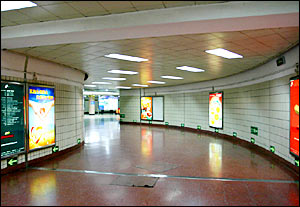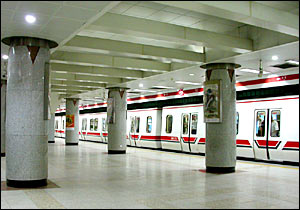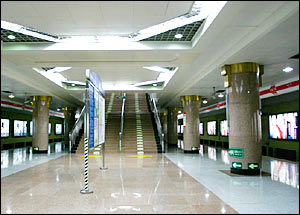Work will start in Beijing this month to make the city's subway
stations more convenient for the handicapped.
The focus of the work on the city's No. 1 and No. 2 subway lines
will be restrooms, tactile paths for the blind, telephones, signs
and elevators.
Xizhimen Station, on the No. 2 line, will be the first to be
renovated, with the entire project scheduled for completion by the
end of next year.
Basins in the restrooms of the 30 subway stations will be lowered
to facilitate use by people in wheelchairs. Railings will be
installed on both sides of every lavatory.

The height of
public telephones in the stations will also be lowered to?one
meter.
Tactile paths for the blind and partially sighted will be laid
on all walkways in subway stations.
Signs will be installed to indicate clearly seating that is
designated for the disabled. Some signs indicating directions and
locations will include Braille.
Xizhimen Station will also install a special lift so that people
in wheelchairs can get from one floor to another with the push of a
button. It will be the first of its kind in China.
Sources with the Beijing Urban Construction Design Institute
said that the blueprints for the project have been completed.

The whole
renovation project will cost more than 10 million yuan (US$1.2
million), including 500,000 yuan (US$60,000) for the work at
Xizhimen.
Work will be done at night and the operation of the two subway
lines will not be affected.
As the first two subway lines built in Beijing, the No. 1 and
No. 2 lines have been operational for more than 30 years.
The Beijing Municipal People's Congress -- the city's
legislature -- adopted the Beijing Regulation on Construction and
Management of Barrier-free Facilities in April. The regulation,
which came into effect in May, is the first local legislation ever
enacted on this issue in China.

It requires public
transport facilities to take the lead in improving access and
convenience for the handicapped. Hospitals, banks, public toilets
and parks are also included.
China's first tactile path for the blind was installed on
Beijing's Landianchang Street in 1988. More than 3,000 buildings
have so far been renovated to make them more convenient for the
handicapped, while 808 kilometers of tactile paths and 200
barrier-free public toilets have been built.
Among Beijing's population of 14.7 million, 622,000 are
handicapped and 1.9 million are senior citizens.
(China Daily August 17, 2004)